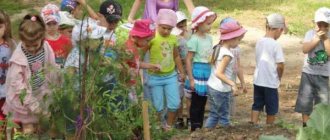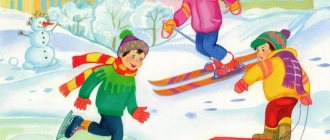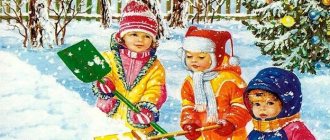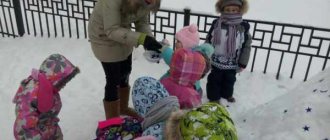card index of walks preparatory group.
Preparatory group (October)Card No. 23
1. Observation of the sun.
Objectives: to form the concept that life on Earth requires the sun; establish a connection between summer and autumn daylight hours; find out the importance of the sun for the life and growth of plants.
- Look how the plants have changed with the arrival of autumn?
— What do plants lack in the autumn season?
— What does the sun give to plants?
Remind children that the Sun is the source of light, heat and life on Earth. Light and heat spread in all directions from it. If the Sun became cold, the Earth would plunge into darkness. All plants and animals would die from the cold and darkness.
The sun is a red-hot spherical body; it can be compared to a burning stove, red-hot iron.
A hot substance emits light, i.e. shines. The Sun also shines, its light reaches the Earth, which is why we are so warm and light during the day. Light from the Sun reaches the Earth in 8 minutes 19 seconds. The sun shines unusually strongly, so even if we are at a great distance from it, we cannot look at it directly, it hurts our eyes. In addition to light, heat comes from hot bodies. So the Sun gives off heat to other planets, as well as to our Earth. Therefore, we bask in the sun, we feel warm.
Invite the children to look at the sun; if it is not there, then find out where it is (hidden behind the clouds).
—What do you feel when you turn your face to the sun?
(the sun is warming, but not as much as in summer)
- Is it possible to look at him directly, does it hurt your eyes?
2.Learning the poem: The sun is smiling - Golden rays
The sun is swinging on a curly cloud.
The sun throws golden balls.
Sunbeams dive into puddles.
L 3. Research activities
.Put 2 pebbles, one in the sun, the other in the shade. After some time, we check which pebble is warmer. We conclude that objects heat up faster in the sun than in the shade.
4. Outdoor game
“Wolf in the ditch” (learning) (OD - jumping). Goal: to develop long jump skills, learn to listen to the teacher’s signals.
Preparatory group (October)
Card No. 24
Watching the sky and rain.
Goal: - learn to determine the nature of autumn rains
Sky observation. Increasingly gray, seems low, completely covered with heavy clouds moving quickly across the sky. Find out the reason for the rapid movement of clouds.
1. Conversation.
Riddle: What kind of ceiling is this? Sometimes he is low, sometimes he is high,
Sometimes gray, sometimes whitish, sometimes slightly bluish.
And sometimes it’s so beautiful - lace and blue-blue.
(Sky)
Precipitation monitoring. The nature of precipitation in September is rain and fog. Children find the differences between long and short rains.
What can you say about rain in autumn? (drizzles, drips, pours, walks, drips, whips, makes noise, knocks on the roof).
Poem by S. Egorov “Autumn”: All clouds, clouds. Rain.
Cold as ice
Spiky like a hedgehog
It wanders through the autumn.
2.Research activities
Find leaves that, when torn off, immediately fall down.
Find the leaves that fly, slowly swaying from side to side
side.
Find leaves that fly, clinging to branches. Make a pattern on the asphalt from fallen leaves.
3. Labor activity
Assisting the janitor in clearing leaves from the kindergarten area.
Goal: to consolidate the ability to work together, achieving the completion of a task through joint efforts.
4. Outdoor game
"Wolf in the Moat" (OD - jumping) (known)
5.Individual work.
Jumping on two legs while moving forward.
Target:
develop coordination of movements.
Didactic games “Autumn” in the younger group
We offer simple educational games that will help younger preschoolers get acquainted with autumn.
Apples and leaves
For the game, prepare a table with 2 cells: label the first “apples”, the second – “leaves”. Also cut out images of apples and autumn leaves in different shapes, colors and sizes. Ask the student to correctly distribute the objects into cells.
Arrange the leaves by size
To play, cut out images of autumn leaves in 3 sizes: large, medium and small. Make a table with 3 matching cells. Ask your child to sort the images into cells.
Autumn
This is a finger game. Here is the accompanying text for it:
A cold breeze blew, the children blew air through their mouths;
He instantly blew the leaves off the branches. – move their fingers in different directions, blow on them;
The leaves are falling, spinning,
They lie down quietly on the grass. – smoothly swing their arms;
The rain has wet the leaves, - with the fingers of the left hand they tap on the palm of the right, then vice versa;
The hail has punched holes in them; the fingers of one hand, clenched into a pinch, are knocking on the palm of the other;
And the frost grabbed them - they knock with the fist of one hand on the palm of the other;
And the snow fell. – slowly and smoothly move the brushes up and down.
Didactic games on the theme “Autumn” in the preparatory group
In the preparatory group, preschoolers prepare to enter school, receive basic philological, mathematical and natural history knowledge, learn to analyze and construct sentences correctly.
Favorite autumn
Invite the students to tell how they feel about autumn, why they love it, and what they don’t like about this time of year. Answers should be detailed and begin with the following phrases:
- for me autumn is...;
- I like autumn because...;
- I don't like autumn because...
One or more
The game develops the skill of forming words in the plural. The presenter says a phrase, and the players change it. Here are examples:
- a rainy day has come - rainy days have come;
- a gray cloud hangs - gray clouds hang;
- light rain began to fall; light rain began to fall;
- a cold wind blew - cold winds blew;
- a leaf falls from a tree - leaves fall from trees;
- the day has become short - the days have become short;
- the bear lies down in a den - bears lie down in a den;
- the flock of cranes flew away - the flocks of cranes flew away.
Describe it beautifully
The presenter calls the word, and the players take turns listing suitable epithets:
- autumn – rainy, golden, clear, fine, cloudy, late, warm;
- the forest is motley, quiet, bare, sad, yellowed, dark;
- trees - yellow, golden, red, red, bare, multi-colored, bright, beautiful;
- foliage - fallen, yellowed, withered, wet, golden, brown, withered.
The game teaches you to select adjectives for nouns and develops your imagination.
Didactic games “Autumn” in the middle group
In the middle group, games should expand thematic vocabulary, consolidate ideas about autumn processes and phenomena, develop concentration and thinking abilities.
The animals are stocking up
The game introduces them to the world around them; preschoolers develop an idea of what animals eat in the wild. For the game, prepare images of forest animals, as well as their food: plants, nuts, mushrooms.
Pair or individual game. Children take turns taking a picture of food and saying that they see in the picture which animal eats it. Then they put the image on the picture of a suitable animal.
Autumn
The purpose of the didactic game “Autumn” is to form and consolidate an idea of what natural phenomena are considered autumn, and to expand the thematic vocabulary.
For the game, prepare pictures that depict scenes that take place in different seasons of the year: falling snow, rain and puddles, yellow trees, bright sun, snowmen, blooming flowers, children on skis, starlings in birdhouses, etc. Lay out the images in front of the student and ask them to choose pictures in which actions can only take place in the fall.
Which tree is the leaf from?
The game broadens your horizons and teaches you to recognize different types of trees by their leaves. Preschoolers learn to form adjectives, they develop speech skills, memory and concentration. To play, cut out realistic images of autumn leaves from thick paper. If there are many different types of trees in the kindergarten yard, you can collect real leaves.
Place the collected leaves in a box. Children take turns taking a leaf out of it, looking at it, trying to find out what tree it comes from. First they name the tree, then form the corresponding adjective. For example: “This is an aspen leaf. This is an aspen leaf."
Fun outdoor games for children in autumn
Fun outdoor games for children in autumn
1. In search of treasure. Take some kind of toy, sweets, etc. as a “treasure”. It's best to wrap it in foil. Show the sealed “treasure” to the children and ask them to close their eyes. Hide the “treasure” in a tree, behind a stump, swing, bench or somewhere else. Let the children go on a search. Whoever finds the “treasure” first wins.
2. Find a match. The leader distributes multi-colored circles or flags to all children (a pair of each item). At the leader’s signal, the children run, and when they hear a clap or the sound of a whistle, everyone must find a pair based on the color of the circle or flag and hold hands. An odd number of children can also take part in the game, then one will be left without a pair and will leave the game.
3. Reviving objects. This game is especially suitable for little ones. At home, cut out funny eyes from paper and take a piece of plasticine and go for a walk with the children. Let the children choose which objects they want to revive - flowers, trees, carousels... You can even arrange a competition between the children to see who can “revive” the objects the fastest. This develops children's imagination well.
4. Ring. Children sit on a bench or stand in a row. The leader takes a ring or some other small object and pretends to place this ring in the palms of each of the players. Then he says: “Ring, go out onto the porch!” and the one who really has the ring left in his palms tries to quickly jump out, and the other children try to prevent him from doing this. If the player manages to jump out, then he takes the place of the leader.
5. Find a plant. The children turn away, and the leader picks a leaf or any plant. The children’s task is to find the same one as quickly as possible. Whoever is first becomes the leader.
6. In the sandbox. We take some object, ask the children to turn away, and bury this little thing in the sandbox. Children must dig with shovels and find the buried object. (It’s very good to play this game on the beach. You just need to outline the area for searching).
7. Balloon tennis. Take badminton or tennis rackets. Inflate a balloon and use it instead of a tennis ball or shuttlecock. The balloon flies for a long time, and the child has time to think a little about where to run and hit the ball.
8. Winding the rope. Only two people can play this game. If there are more people willing, then you can play alternately with the winner, and the rest are fans. Take two identical branches or sticks and a longer rope (3 meters or more). We tie a branch or stick to each end of the rope. In the middle of this rope we tie a flag or make a knot. Each participant takes a stick and moves away so that the rope itself is well stretched. So, at a signal, the children begin to wind the rope around their stick. Whoever reaches the knot or flag the fastest is the winner!
9. Crow. One child is blindfolded and stands with his back to the children. Each player must approach the leader and place his hand on his shoulder. The driver says: “Caw, crow!” The player croaks, and the driver guesses the name of the one who croaked. If he guesses correctly, he changes places with the player.
10. Rain and sunshine. We draw a circle on the asphalt and ask the children to stand in it. When the presenter says “Sunshine,” the children leave the circle, run, and jump. And when they hear the word “Rain,” the children should form a circle as quickly as possible. Whoever is last loses.
11. Snake. Children join hands, and then a whole “chain” is built. The presenter takes the last one by the hand and leads this “snake”, making various unexpected turns. The kids must hold on tightly so as not to break the “chain.” If the children are quite old, then you can run like a snake.
12. “Deaf telephone.” Children line up. The first in the row whispers a word into the ear of his neighbor - he repeats this word to the other in a whisper, and so on, the last one names the word he heard. Usually the named word only causes laughter.
13. Repeater. Children stand in a circle, the first player shows some movement (for example, clapping), the next one repeats everything and adds another movement. So everyone must repeat all the movements shown in front of him and add his own. Whoever messes up is out of the game.
14. Edible - inedible. For this game, take a ball. Have the children stand in a row or sit on a bench. The driver begins to throw the ball to each player, naming an edible or inedible object. If the named item can be eaten, the children catch the ball, if not, they throw it back to the driver.
15. Drive more quietly. Children stand on one side of the “road”, and the leader stands on the other, turning his back to everyone. The presenter says: “The slower you go, the further you will go.” - the children begin to run, trying to reach the finish line as early as possible. After a few seconds, the presenter says: “Stop!” – the children stop running and freeze. The presenter turns around, and if he sees any movement of any player, he is eliminated from the game. The winner is the one who runs to the finish line first.
16. Hot potatoes. Children stand in a circle. The driver gives a signal or turns on music (you can use music from your phone). Children begin to throw the ball to each other, trying to get rid of it as quickly as possible. When the driver gives a signal or turns off the music, the one who still has the ball in his hands is eliminated from the game. When 1 player remains, the game ends and he becomes the winner.
17. Fishermen and fish. Two children are chosen as fishermen, and the rest are fish. The children begin to dance around the fishermen and sing a song: Fish live in the water, There is no beak, but they peck. If they have wings, they don't fly, but they don't have legs, but they walk. They don’t make nests, but they take out the babies. The “fishermen” join hands and quickly catch all the scattering “fish”. The “fish” that come across already become “fishermen”. Now these “fishermen” join hands and begin to catch other children. So the “Network” becomes even larger.
18. Simon speaks. The presenter must say the words: “Simon says” and then say what all the children should do. If the words: “Simon says” do not sound, then the command should not be executed. And the children answer: “Simon didn’t say that.” For example, the presenter says: “Simon says - run!” Children are running. Anyone who begins to carry out any command from the leader, without saying “Simon says,” misses a turn or leaves the game.
1. In search of treasure. Take some kind of toy, sweets, etc. as a “treasure”. It's best to wrap it in foil. Show the sealed “treasure” to the children and ask them to close their eyes. Hide the “treasure” in a tree, behind a stump, swing, bench or somewhere else. Let the children go on a search. Whoever finds the “treasure” first wins.
2. Find a match. The leader distributes multi-colored circles or flags to all children (a pair of each item). At the leader’s signal, the children run, and when they hear a clap or the sound of a whistle, everyone must find a pair based on the color of the circle or flag and hold hands. An odd number of children can also take part in the game, then one will be left without a pair and will leave the game.
3. Reviving objects. This game is especially suitable for little ones. At home, cut out funny eyes from paper and take a piece of plasticine and go for a walk with the children. Let the children choose which objects they want to revive - flowers, trees, carousels... You can even arrange a competition between the children to see who can “revive” the objects the fastest. This develops children's imagination well.
4. Ring. Children sit on a bench or stand in a row. The leader takes a ring or some other small object and pretends to place this ring in the palms of each of the players. Then he says: “Ring, go out onto the porch!” and the one who really has the ring left in his palms tries to quickly jump out, and the other children try to prevent him from doing this. If the player manages to jump out, then he takes the place of the leader.
5. Find a plant. The children turn away, and the leader picks a leaf or any plant. The children’s task is to find the same one as quickly as possible. Whoever is first becomes the leader.
6. In the sandbox. We take some object, ask the children to turn away, and bury this little thing in the sandbox. Children must dig with shovels and find the buried object. (It’s very good to play this game on the beach. You just need to outline the area for searching).
7. Balloon tennis. Take badminton or tennis rackets. Inflate a balloon and use it instead of a tennis ball or shuttlecock. The balloon flies for a long time, and the child has time to think a little about where to run and hit the ball.
8. Winding the rope. Only two people can play this game. If there are more people willing, then you can play alternately with the winner, and the rest are fans. Take two identical branches or sticks and a longer rope (3 meters or more). We tie a branch or stick to each end of the rope. In the middle of this rope we tie a flag or make a knot. Each participant takes a stick and moves away so that the rope itself is well stretched. So, at a signal, the children begin to wind the rope around their stick. Whoever reaches the knot or flag the fastest is the winner!
9. Crow. One child is blindfolded and stands with his back to the children. Each player must approach the leader and place his hand on his shoulder. The driver says: “Caw, crow!” The player croaks, and the driver guesses the name of the one who croaked. If he guesses correctly, he changes places with the player.
10. Rain and sunshine. We draw a circle on the asphalt and ask the children to stand in it. When the presenter says “Sunshine,” the children leave the circle, run, and jump. And when they hear the word “Rain,” the children should form a circle as quickly as possible. Whoever is last loses.
11. Snake. Children join hands, and then a whole “chain” is built. The presenter takes the last one by the hand and leads this “snake”, making various unexpected turns. The kids must hold on tightly so as not to break the “chain.” If the children are quite old, then you can run like a snake.
12. “Deaf telephone.” Children line up. The first in the row whispers a word into the ear of his neighbor - he repeats this word to the other in a whisper, and so on, the last one names the word he heard. Usually the named word only causes laughter.
13. Repeater. Children stand in a circle, the first player shows some movement (for example, clapping), the next one repeats everything and adds another movement. So everyone must repeat all the movements shown in front of him and add his own. Whoever messes up is out of the game.
14. Edible - inedible. For this game, take a ball. Have the children stand in a row or sit on a bench. The driver begins to throw the ball to each player, naming an edible or inedible object. If the named item can be eaten, the children catch the ball, if not, they throw it back to the driver.
15. Drive more quietly. Children stand on one side of the “road”, and the leader stands on the other, turning his back to everyone. The presenter says: “The slower you go, the further you will go.” - the children begin to run, trying to reach the finish line as early as possible. After a few seconds, the presenter says: “Stop!” – the children stop running and freeze. The presenter turns around, and if he sees any movement of any player, he is eliminated from the game. The winner is the one who runs to the finish line first.
16. Hot potatoes. Children stand in a circle. The driver gives a signal or turns on music (you can use music from your phone). Children begin to throw the ball to each other, trying to get rid of it as quickly as possible. When the driver gives a signal or turns off the music, the one who still has the ball in his hands is eliminated from the game. When 1 player remains, the game ends and he becomes the winner.
17. Fishermen and fish. Two children are chosen as fishermen, and the rest are fish. The children begin to dance around the fishermen and sing a song: Fish live in the water, There is no beak, but they peck. If they have wings, they don't fly, but they don't have legs, but they walk. They don’t make nests, but they take out the babies. The “fishermen” join hands and quickly catch all the scattering “fish”. The “fish” that come across already become “fishermen”. Now these “fishermen” join hands and begin to catch other children. So the “Network” becomes even larger.
18. Simon speaks. The presenter must say the words: “Simon says” and then say what all the children should do. If the words: “Simon says” do not sound, then the command should not be executed. And the children answer: “Simon didn’t say that.” For example, the presenter says: “Simon says - run!” Children are running. Anyone who begins to carry out any command from the leader, without saying “Simon says,” misses a turn or leaves the game.
Get text
Didactic games “Autumn” in the senior group
In the older group, games are needed to improve oral speech and the ability to define concepts, expand thematic knowledge, develop observation, perseverance, and the ability to perform collective and individual work. We must not forget about the physical development of preschoolers.
Make a proposal
The player receives a series of nouns, based on which he mentally composes and pronounces a thematic phrase. For example: umbrella, protection, rain - an umbrella protects from rain. Or: galoshes, rubber, shoes - galoshes are rubber shoes.
Take the golden leaf
This is an active game, the purpose of which is to teach the alternation of movements of different speeds and intensity. The game improves listening comprehension, develops the ability to work in a team, and improves the overall physical development of the preschooler.
The game is played on a warm autumn day in the courtyard of the kindergarten, when leaves of different colors are actively falling from the trees. The leader gives the command to move, to make any movements: run, walk, jump, wave your arms, dance. As soon as the presenter says “One, two, three! Take the golden leaf!”, the children stop, look at their feet, and pick up the leaf, painted exactly yellow. You cannot pick leaves from trees; you need to take only those that are on the ground. The first one to find a yellow piece of paper under his feet wins.
At the next stages of the game, the task can be changed, for example, “take a red leaf,” “take a maple leaf,” “take two leaves.”
Finish the sentence
Say the beginning of the topic sentence, and the children must complete it:
- in the fall I wear it outside - what? – coat, jacket, boots, shoes, hat, scarf;
- the foliage on the trees has become - what? – yellow, golden, red, sluggish;
- farmers harvest from fields and orchards - what? – harvest, fruits, vegetables;
- mushroom pickers collecting in the forest - what? – mushrooms, boletus, honey mushrooms, chanterelles, saffron milk caps, russula;
- I'll make a feeder for - who? – birds, tits, sparrows, squirrels;
- flying south - who? - birds, cranes, storks, swans, starlings, rooks, larks.






